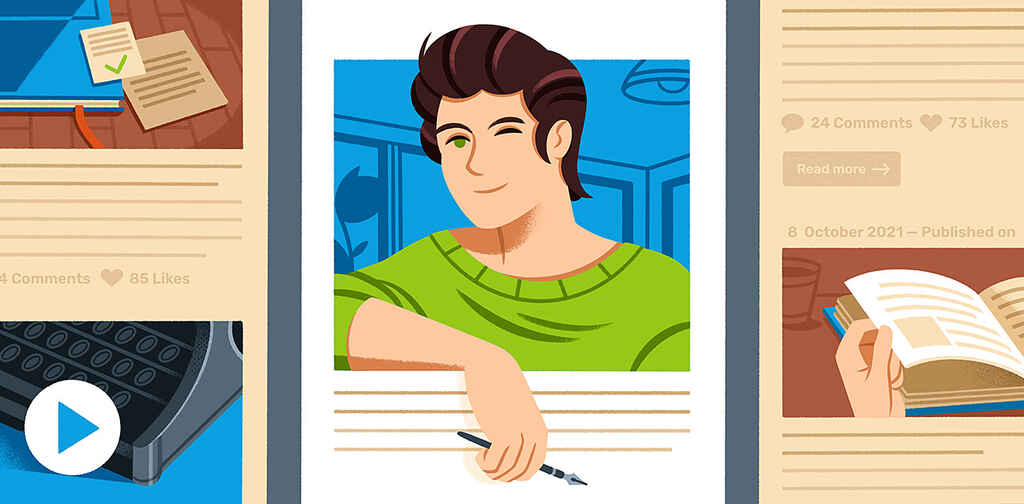Blog • Understanding Publishing
Posted on Apr 28, 2023
5 Ways to Save on Your Self-Publishing Budget
Martin Cavannagh
Head of Content at Reedsy, Martin has spent over eight years helping writers turn their ambitions into reality. As a voice in the indie publishing space, he has written for a number of outlets and spoken at conferences, including the 2024 Writers Summit at the London Book Fair.
View profile →Now that you have a general idea of the average cost to self-publish a book, let’s look at a few ways that independent authors can get more bang for their buck. These tips could save you thousands without sacrificing an ounce of quality in your book.
1. Scout for talented but newer professionals
There are many pros out there who are great at what they do but don’t have much experience — perhaps they’ve just graduated or changed careers. This makes them way more affordable than their “ten years with a Big 5 publisher” counterparts!
So try and seek out editors and designers who have just a few projects under their belt — enough to prove their competence and abilities, but not so many that you’ll be faced with an exorbitant price tag.
2. Self-edit extensively before hiring an editor

Another major cost-saving measure is to work on your manuscript as much as possible before submitting it to editors. This is especially important for those hoping to get a developmental edit! If you haven’t rewritten your manuscript as much as possible before hiring an editor, you’ll end up paying them to tell you things you already know.
Self-editing can help with copyediting costs, too; the smoother your word usage and descriptions, the fewer the changes your copy editor will have to make.
Q: What steps can authors take before hiring editors to reduce editing costs while maintaining quality?
Suggested answer
Share your finished work with a range of trusted people, ideally those who are your target readership (not only people you know). These are called beta readers, test readers or advanced copy readers. Have a few questions prepared for your blindspots (Is character A convincing? Is there enough/too much cross-referencing to the glossary? Am I overusing any words? What do you think of the X, Y, Z? Is the dialogue in Chapter X convincing?). Rewrite your draft with brave attention to the feedback, but keeping true to your author's voice, and then send it to a professional editor.
Alex is available to hire on Reedsy ⏺
There are several things authors can do to help manage editing costs before hiring a professional. First, thorough self-editing can make a big difference—addressing obvious typos, inconsistencies, and tightening your prose will reduce the amount of work needed later. Tools like Grammarly or ProWritingAid can be useful for catching basic errors and improving clarity. Involving beta readers is another great step; their feedback on character arcs, plot holes, and overall flow can help strengthen your manuscript before an editor even sees it. It's also important to know what kind of editing you need—whether it's line editing for style and clarity or just a final proofreading pass—so you're only paying for what truly benefits your work. Consistent formatting and sharing any specific style preferences can further streamline the process. By preparing your manuscript, you ensure that the editor’s focus remains on enhancing your story's impact, rather than errors you could've fixed on your end, ultimately saving time and money.
Eilidh is available to hire on Reedsy ⏺
To help manage costs as well as to speed your book to completion, you can familiarize yourself with the various kinds of editing and target your request accordingly. Reedsy has some great educational material on this. I've noticed that many authors will check both "copyediting" and "proofreading" but often that's because they think they're synonymous. They're related, but not the same. The same editor could probably do both or either, but you shouldn't have to pay for two stages if you only need one.
Eric is available to hire on Reedsy ⏺
At the easiest and most basic level, do a spellcheck, ensure consistency in usage of terms etc, and fix obvious layout/format issues. Also, if you're concerned about wider things like whether your book is interesting or clear enough, give the manuscript to some smart friends or colleagues to get their feedback before sending to an editor
John is available to hire on Reedsy ⏺
3. Combine services where possible
Many publishing professionals are specialists in a number of skills and niches. Some are happy to bundle together a few services and offer them for less than you would pay if you hired two separate people. Potential combinations to look out for include:
- Cover designers who can also handle your interior formatting;
- Copy editors who will also proofread your manuscript;
- Translators who will also write your sales page metadata.
With some careful combinations, you could look to save up to 30%, compared to getting the services separately.
In case you missed it, here's our free report with the most up-to-date averages for publishing services.

FREE RESOURCE
The Cost of Self-Publishing in 2023
Get an inside look at 2023 rates for professional self-publishing services.
4. Request a cover design based on stock imagery
This one may be hard to hear, but if you want to cut design costs, go with a cover that utilizes stock imagery rather than a bespoke illustration (which can get quite expensive). The trick is to find a designer who can take a visual asset from Shutterstock and make it look classy and professional.

For example, the cover for Pik-Shuen Fung’s debut novel Ghost Forest looks like it may have been based on a painting commissioned specifically for this novel — but it’s actually a composite of stock images that would have been relatively affordable to license.
On the other hand, once you start getting an illustrator involved, the time required to create your cover will grow exponentially. Even a relatively simple cover like this re-issue of Ramona the Pest (below) would likely have cost the publisher significantly more to produce.

So, when you’re searching for potential cover designers, look for ones whose portfolios show a talent for manipulating stock images in inventive ways. These are the ones who can help your book look like a million bucks for just a fraction of that cost.
Check out our book cover art gallery for more examples of great covers that utilize stock images!
Q: What role does professional experience play in helping authors create more polished and impactful books?
Suggested answer
I'm an author and an illustrator so I understand how precious a story can be to the writer. The stories come from the heart, whether they're funny, silly, poignant, loving or celebratory, and the illustrations need to reflect that. I can figure out the themes of the story and the overall feeling the author is aiming for, and then make sure my illustrations don't just show what's being said, but also add to the story. That's important to me – for the illustrations to do more than simply reflect the text, but to add layers to the story for the reader. That can be done in a variety of ways – showing emotions or time passing via the character or scene colours/seasons, or light/shade; or I may add elements such as an animal who follows the main character through the story (but isn't mentioned in the text) so there's something for readers to see and observe for themselves, without being told in the text why it's there. Telling the story visually as well as telling it via the words.
Having self-published my own books means I can provide useful elements within my illustration packages as I know what's required for marketing or advertising. So, for example, while I'm illustrating the book's imagery, I always make sure I create some cut-outs and/or vignettes of the characters as separate files during the process. That means that the author gets useful images for marketing, flyers, ads etc, without having to pay extra for those after the book is finished. I always try do some in-progress videos of me creating the artwork as I know how popular those are on social media, which helps the author get more attention for their book.
I'll also be aware of potential licensing for a character too, which I'll discuss with the author – so we'll create a main character that would work well in the form of a plush toy, for example.
Siski is available to hire on Reedsy ⏺
I have a background in educational design for children. I also used to design kids magazines, and now I design and illustrate all types of children's books. When designing educational content I learnt the importance of making the content as accessible as possible, so now I always question whether the fonts are going to be ok for children with dyslexia, or whether the characters are representative enough.
My time in magazine and marketing design for children taught me about the importance of the design hierarchy. What is the key message of this content? Are we conveying that message clearly and engagingly enough?
With me helping you to publish your book you have a wealth of specialist children's publishing knowledge at your disposal, so you can be assured of a professional, trade-standard book at the end of our collaboration.
Sarah is available to hire on Reedsy ⏺
Because I've been doing this for so many years, I know about pacing and what I have always called, "the page turn."
I am aware that I want to encourage readers to turn the page with some excitement when they're reading.
And I know about movement and drawing "to the right". Things like a car or someone running or birds flying should move to the right side of the page at all times.
These things are important when setting up a book.
I think my experience has mad me expert in pacing and in designing a book to be fun to read.
And another value my experience brings is an expertise in drawing people and expressions. I can translate the emotions so easily because I've been doing it for so long and that's what is fun for me. That's what I enjoy. That's why I do this!
Penny is available to hire on Reedsy ⏺
5. Grow your following before you publish
 We’ve covered how to save on editing and design costs, but what about marketing costs? The best way to minimize your spending is to establish a following early on — ideally, months or years before publishing your book. That way, once you publish, you’ll have a built-in street team ready to support you.
We’ve covered how to save on editing and design costs, but what about marketing costs? The best way to minimize your spending is to establish a following early on — ideally, months or years before publishing your book. That way, once you publish, you’ll have a built-in street team ready to support you.
Of course, building a following is much easier said than done, especially from the ground up. One way to do this is to simply become more active on social media, where you can interact with others and construct your authorial image. You might also consider starting a blog if you don't already have one, so you can reach a consistent audience on your very own platform.
Rather than promoting your work, focus first on providing valuable content and maintaining genuine relationships. Eventually, you’ll be able to snowball these relationships into a full-fledged community — and from there, convert them into customers and start making money as an author.
Like any business, self-publishing requires an upfront investment. With these tips, you’ll hopefully find opportunities to manage your budget while maintaining the highest of standards.









